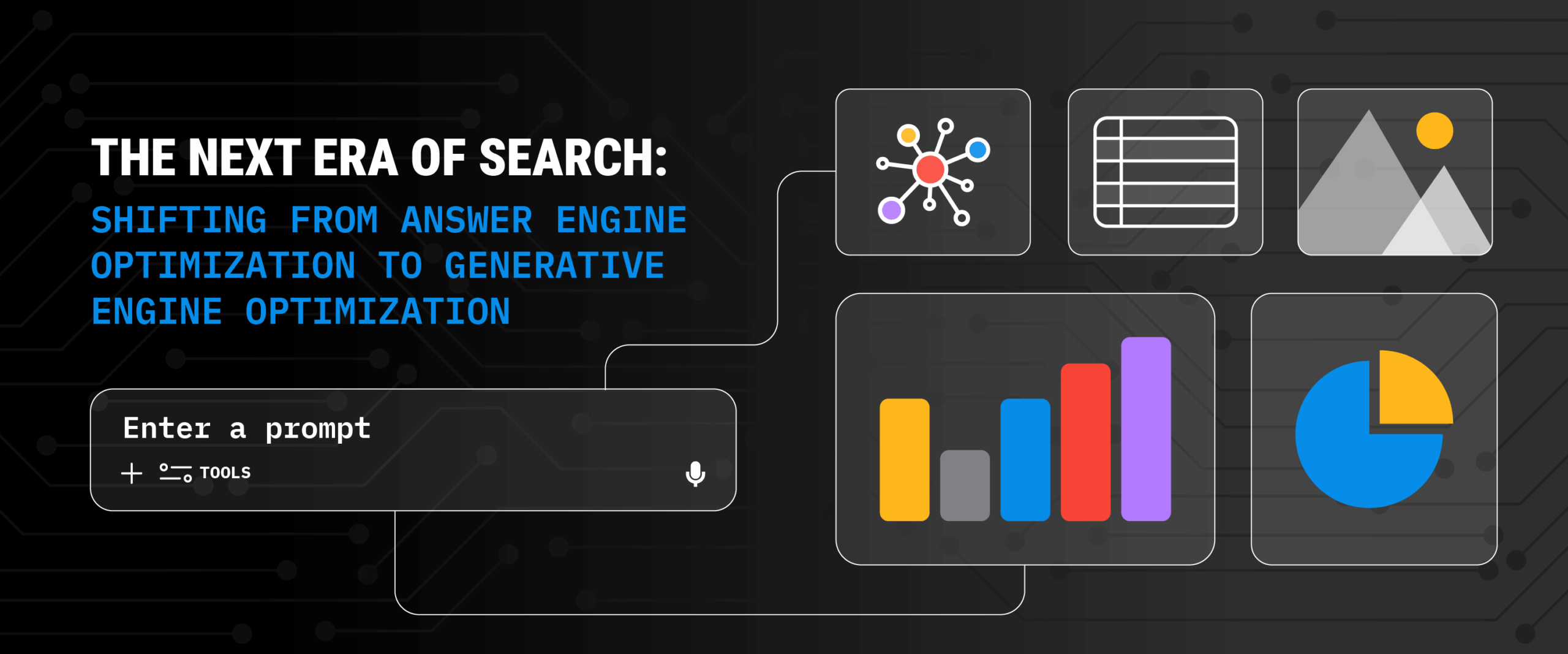The rise of AI has triggered a fundamental evolution in how people find information, moving us from a world of keywords and links to one of conversations and direct answers. Being found is no longer just about website performance; it’s about clear brand positioning and a connected marketing strategy.
Search is evolving in three key areas. Understanding them is the first step to building a future-proof brand.
Shift 1: The Evolution of Prompts & Platforms
How we ask questions and where we go for answers has fundamentally changed. The simple act of typing keywords into a search bar is being replaced by a richer, more diverse set of behaviors. Inputs are becoming longer, more specific, and multi-format, featuring voice commands to assistants, image-based queries, and even audio prompts for sounds and music.
Simultaneously, the search experience has broken free from a single blue box. People now seek answers across a new ecosystem of platforms, including the conversational interfaces of ChatGPT, the visual feeds of TikTok, the product pages of Amazon, and the contextual environment of Maps.
Optimization is no longer about being broadly relevant on one platform; it’s about having focused, intentional messaging that can be understood across many.
Shift 2: The Transition from Algorithm to Authority
The second major shift is in how information is sourced and vetted. Traditional SEO focused on optimizing content to please a technical algorithm for relevance – rank highly & broadly across topics to succeed. AI models, however, work differently. They seek to establish authority by synthesizing information from a wide array of trusted, high-traffic sources.
An analysis of 10 million AI citations shows exactly where these models go to school:
- Google AI Overviews heavily prioritizes community discussion. Its top sources are platforms like Reddit (21%), YouTube (18.8%), and Quora (14.3%).
- ChatGPT, in contrast, leans heavily on encyclopedic sources, with Wikipedia making up a staggering 47.9% of its citations.
The glaring insight is that brand websites are not the primary source of truth. Your brand’s story is being defined by the conversations, reviews, and content living on these community hubs. Having wide prominence and influence within AI search requires your brand consistently showing up across the web, not just building links back to your domain. That’s a brand & messaging challenge disguised as an SEO strategy.
Shift 3: The New World of Answers & Actions
For two decades, the goal of search was to win a click that drove traffic to your website. That model is breaking. AI search is designed to give people a direct answer, preventing the need for further follow-up.
This creates a non-linear path to purchase that is far more complex and harder to control. As AI gains wider adoption, success shifts from driving traffic through highly-optimized conversion funnels to having a consistent and compelling presence within as many LLM reference points as possible. Measurement must also evolve, moving away from strict attribution and toward model-based approaches that capture broader influence.
Your Playbook for AI-Engine Prominence
Reacting to these shifts requires a new playbook—one focused on influence, clarity, and brand hygiene.
Recommendation 1: Be More Focused—Consistency Over Quantity
LLMs are built on patterns. The more diverse and disconnected your brand’s content, the less clear that pattern becomes. A high-volume, broadly relevant content strategy now works against you. The new mandate is to have a ruthless focus on a clear brand and product positioning, executed with brutal consistency across every touchpoint. This creates a strong, coherent signal the AI can easily understand and trust.
Recommendation 2: Your Brand Is Not Your Website
The data is clear: LLMs are trained on community sources much more strongly than brand websites. This leads to an inescapable conclusion: Optimizing for AI search is not a website project. It is a holistic brand and marketing effort that connects your messaging consistently across in-store experiences, product design, paid and earned media, reviews, social channels, and influencers. Your brand needs to be represented well everywhere.
Recommendation 3: Think “Push, Not Pull”
Because AI search is designed to be self-contained, it does not exist to bring traffic to your website. We must shift from a “pull” strategy to a “push” mindset. The goal is no longer to pull users into your owned properties but to proactively push a consistent and compelling narrative into the ecosystem of sources where the AI is learning. Winning in this era is about influencing what shows up directly in the model.
Recommendation 4: Stay Nimble and Build for the Future
We are still early in the shift to new search capabilities. The models and platforms will continue to evolve. Because of this, it would be a mistake to hyper-fixate on optimizing for the current models. The most durable and intelligent strategy is to invest in good brand hygiene. Building a clear, consistent, and authoritative brand presence across the entire digital ecosystem is the smartest bet you can make—a foundational asset that will deliver value no matter how the technology changes.
It’s time to build your brand’s playbook for the new era of search. Reach out to newbiz@mythic.us to to build lasting authority where it matters most.
